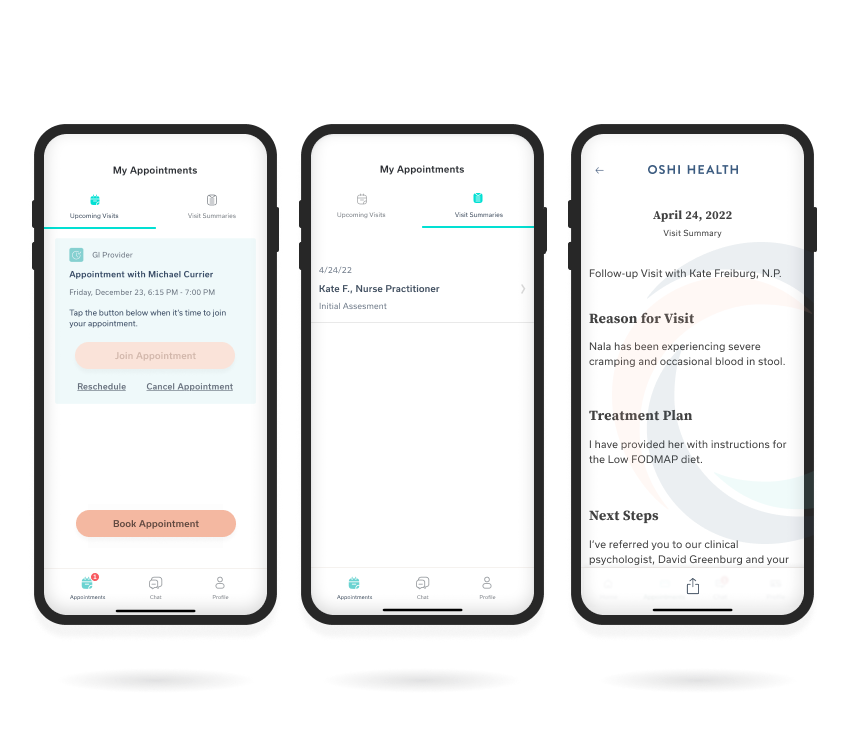Chat Messaging
I led the research and design of a unique messaging solution to meet the requirements of both our patients and our clinical team.
*Due to an NDA certain details of my research findings are omitted or recreated to present this study.

MOBILE DESIGN
Tools: Figma, Useberry, JIRA
Challenge
Patients want access to their care team and prompt answers to their questions. The clinical team wants to meet patient's expectations while also triaging requests, allowing lower-tier providers to respond when appropriate and limiting the need for higher-tier (and cost) providers to spend billable hours texting.
Results
- Chat data was brought into the product and can now be tracked and monitored for trends
- Reduced average chat response time
- Improved patient understanding of tasks managed by each care team member
- Reduction in chat volleys required to successfully resolve patient queries
- Increased daily active users
- Improved CSAT score
My Team
- Lead UX research & design (myself)
- Project manager
- Front & back-end developers
The Project
Research
To inform my approach I needed to know more about how patients and the clinical team were currently chatting, including frequency of inquiry, topics of discussion, and response times. I looked to identify any common trends that may exist and any perceived shortcomings from both our patient's and clinical team's perspectives.
I conducted a series of interviews with three stakeholder groups. Questions for each stakeholder included:
- Patients
- Are the roles of each tier of our clinical team clear: Care Coordinators, GI Providers, Registered Dieticians, Health Coaches, GI Psychologists?
- What have they contacted the care team to ask?
- What is their desired response time?
- Each tier group of the care team
- What if any trends have they identified in the question topics they're asked?
- What are their availabilities for reading and responding to messages?
- What do they consider a reasonable response time?
- Our engineering team
- What vendors are we considering for managing chat?
- What innate features can we utilize to minimize development?
- What vendors are we considering for managing chat?
Findings
After conducting 17 interviews certain trends were identified during synthesis.
- Patients (8)
- Care Coordinator and Health Coach roles were not entirely clear to members making them unsure whom to approach with certain questions
- 24% expected to be able to directly contact their GI Provider or Psychologist directly
- 88% would be Very Satisfied with a chat response time providing a solution within 24-48hrs
- 100% would be more comfortable communicating via chat with a profile photo of their providers
- Each tier group of the care team (8 members)
- Care Coordinators respond within an hour during a staggered 14 hour workday; whereas other providers respond within a 24 hour timeframe
- As the GI Specialist for our patients, a providers must be reachable in the event of an urgent situation at all times
- All patients are assigned to work with a Health Coach and Registered Dietician for a 10-week period unless they refuse this treatment
- Links to treatment information housed in our knowledge base would be shared by Health Coaches and Registered Dieticians primarily through chat
- Engineers (1)
- Reviewed a list of vendors preferred by the Lead Engineer, and we decided to work with CometChat for its functionality, relatively low development lift, and ability to customize the interface
- Reviewed a list of vendors preferred by the Lead Engineer, and we decided to work with CometChat for its functionality, relatively low development lift, and ability to customize the interface
Hypothesis
After my interviews, I began a list of proposed requirements based on stakeholder feedback, which included the following:
- Lists of the most commonly requested tasks each provider is responsible for, so patient questions are sent to the right person
- Providing members direct communication with all care team members, but enabling top-tier clinicians to close channels after a query has been resolved
- Provider headshots in the chat thread
- Messaging regarding what to do in the case of an emergency and a number to call for an urgent response
- Timeframe indicators for average response times
- Ability to share and receive multimedia
- Unfurled links in the chat thread
Testing
Virtual testing was conducted individually with 12 patient participants. Scenarios were designed to test the clarity of UI designs and supporting copy.
Testing methods included:
- A/B Testing to determine preferences for button styling, messaging, and iconography
- Scenarios to test the clarity of signifiers, iconography and general functionality
Final Design
Rounds of user testing and interviews led to a design where chat threads occurred in channels separated by provider type.



Hand-off & Development
The project was demonstrated for the entire company including a prototype, research methods and findings. At handoff I included the following:
- A demo of designs and a clickable prototype
- Figma file with the prototype, hi-fidelity wireframes, and spec doc for a selection of devices
- A design brief with keynotes and links to the Figma file and all other supporting documents
Due to the scale of this project and the number of new features, I met daily on an ad hoc basis with the Lead Engineer to review development progress and answer questions.

Oshi Health & My Role In UXWork Experience

Rebranding & Design LibraryWork History

Sign-up Flow & AcquisitionWork History

Home Screen Research & DesignWork History

Visit History FeatureWork History
Copyright © 2024 Claude Grant